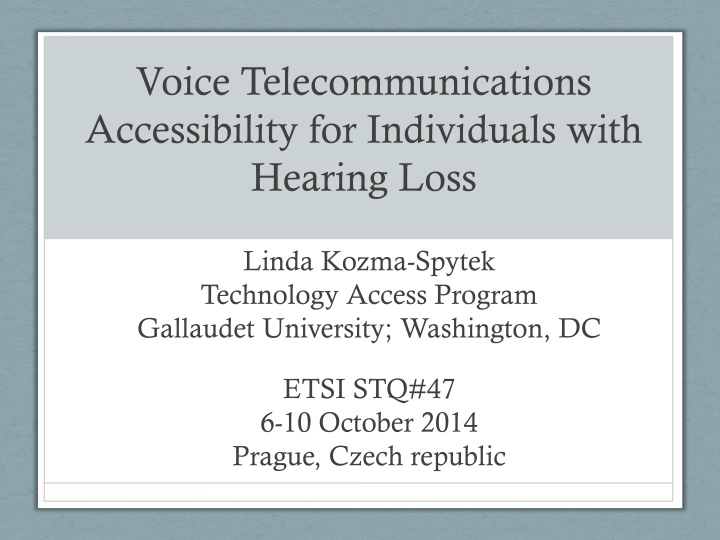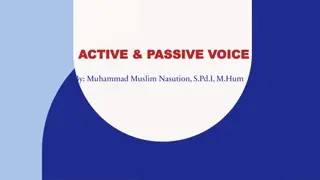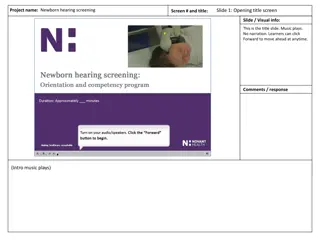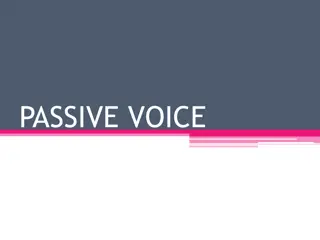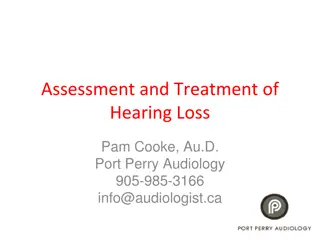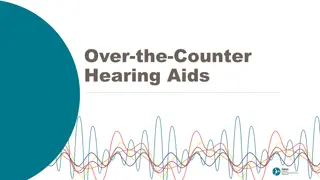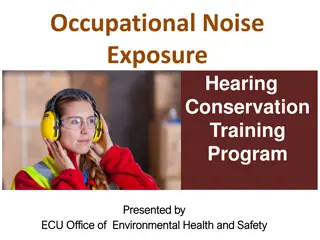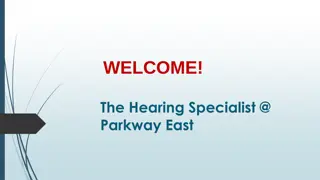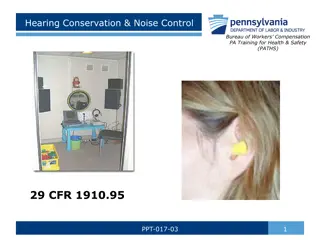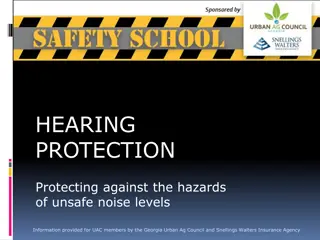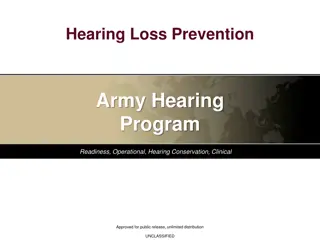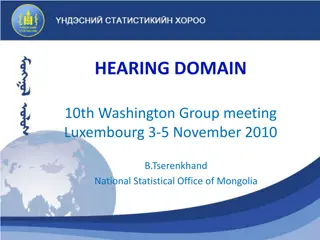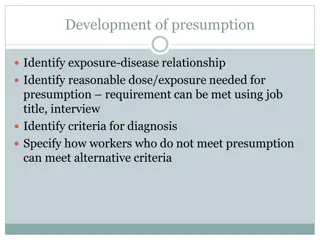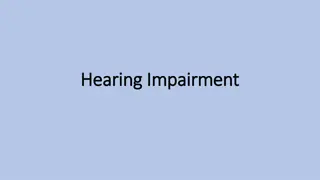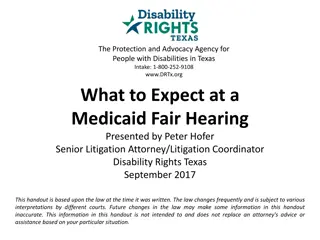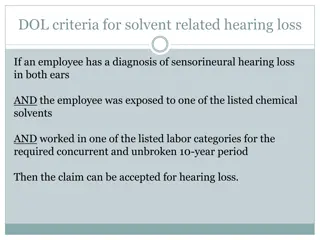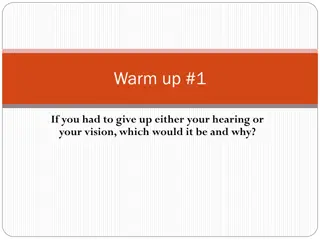Enhancing Voice Telecommunications Accessibility for Individuals with Hearing Loss
This research, conducted at Gallaudet University, focuses on improving voice telecommunications accessibility for individuals with hearing loss. The Technology Access Program, led by Christian Vogler, collaborates with various institutions to further this goal. The research aims to understand technical parameters affecting audio-only and audio/visual telecommunications for people with hearing loss through experiments involving subjects using wireless devices. Factors such as audio/video synchronization, codec audio bandwidth, and environmental conditions are considered to enhance communication effectiveness.
Download Presentation

Please find below an Image/Link to download the presentation.
The content on the website is provided AS IS for your information and personal use only. It may not be sold, licensed, or shared on other websites without obtaining consent from the author.If you encounter any issues during the download, it is possible that the publisher has removed the file from their server.
You are allowed to download the files provided on this website for personal or commercial use, subject to the condition that they are used lawfully. All files are the property of their respective owners.
The content on the website is provided AS IS for your information and personal use only. It may not be sold, licensed, or shared on other websites without obtaining consent from the author.
E N D
Presentation Transcript
Voice Telecommunications Accessibility for Individuals with Hearing Loss Linda Kozma-Spytek Technology Access Program Gallaudet University; Washington, DC ETSI STQ#47 6-10 October 2014 Prague, Czech republic
Technology Access Program (TAP) Christian Vogler, Director TAP has been partnering with: the Trace Center at University of Wisconsin-Madison; Gregg Vanderheiden Omnitor in Sweden; Gunnar Hellstr m on: The Rehabilitation Engineering Research Center on Telecommunications Access (RERC-TA), funded by the National Institute on Disability and Rehabilitation Research (NIDRR), for the past 15 years
Research Goal To better understand the technical parameters that lead to effective audio-only and audio/visual telecommunications by individuals with hearing loss
Voice Telecommunications Accessibility Experiments five with-in subjects experiments, of approximately 120 subjects with hearing loss, have been completed all examine the impact of a variety of technical parameters on voice telecommunications for individuals with hearing loss both simulated and actual wireless device use replication conditions from previous experiments as well as new conditions are included receive-only testing
Participants were 18 years of age or older fluent in English daily hearing aid or cochlear implant users regular users of the voice telephone (rather than TTY, Video Relay Services or Text-Based IP Relay) Depending on the test conditions for a given experiment, subjects may have also had to pass a vision or hearing screening.
We have investigated the effects of presentation mode audio only and the addition of a video channel video quality video frame rate: 30 fps, 15 fps, 7.5 fps audio-video synchrony: -100ms, 0 ms, +100 ms and +200 ms audio re video) audio quality codec audio bandwidth: NB (G.711, AMR-NB) and WB (AMR-WB) data rate: AMR-NB @ 5.9kbps & 12.2kbps; AMR-WB @ 12.65kbps & 23.85kbps environment quiet and the addition of noise (10 dB SNR)
Apparatus simulated telephony application actual wireless device
Dependent Measures Speech intelligibility (experiments 1-5) % words correct for sentence material Sound quality (experiment 5) MOS Mean Opinion Score Subjective mental effort (experiments 1-4) SMEQ Subjective Mental Effort Question Purchase intent (experiments 1-5) yes/no response Response time (experiment 4) end of stimulus to beginning of response in seconds
Speech Intelligibility CASPER sentences 72 Sets: 12 sentences per set; 1 female & 1 male speaker; AV -e.g., Take the steaks out of the freezer and put them on the counter. Remember to take your sister to the airport tomorrow. I quit my job. I have a sweater that would look great with this plaid skirt. Did you go to see the bird exhibit when you went to the zoo? Where did you buy all that new furniture for the house? Put all the golf clubs in the cart. Don't be afraid of the thunder. I really don't like to get injections. The flowers bloomed Do you think we should buy him a savings bond? Have you heard her sing?
MOSMean Opinion Score In this experiment, we are evaluating systems that might be used for voice telecommunications services. You are going to hear a number of recorded sentences. We would like you to rate how good they sound. You will use the following scale to provide your opinion of their overall quality. The overall quality of the speech was: Excellent Good Fair Poor Bad
SMEQSubjective Mental Effort Question How much effort did it take to understand what the woman on the cell phone was saying?
Purchase Intent Would you purchase (and use) a cell phone with this level of quality in order to both hear and lipread your calling partner? Yes No
Presentation Mode and Video Quality Experiments 1 & 2
Test Methods 24 HA/CI users listened at 70 dB SPL via simulated wireless device use to one set of 12 sentences per condition (stimulus validation) Conditions included audio-only with AMR-NB @ 12.2 kbps audio-video with AMR-NB @ 12.2 kbps and QCIF resolution (176x144) 2 frame rates: 15 fps & 7.5 fps 3 levels of audio-video synchrony: -100 ms, 0 ms & +100 ms (A re V) Listeners repeated each sentence to evaluate speech understanding rated mental effort using the SMEQ indicated their likelihood to purchase and use a phone given the rated speech quality
Speech Understanding * * 100 % words understood (n=24) 93% * 93% * * 90 86% * 85% * 82% 80 * 72% Baseline Audio-only 70% 70 60 50 15 15 15 7.5 7.5 7.5 fps A re V -100 ms 0 ms +100 ms -100 ms 0 ms +100 ms
Test Methods 22 HA/CI users listened at 70 dB SPL via simulated wireless device use to one set of 12 sentences per condition Conditions included audio-only with AMR-NB @ 12.2 kbps audio-video with AMR-NB @ 12.2 kbps and near-CIF resolution (306x204) 2 frame rates: 30 fps & 15 fps 3 levels of audio-video synchrony: -100 ms, 0 ms & +100 ms (A re V) Listeners repeated each sentence to evaluate speech understanding rated mental effort using the SMEQ indicated their likelihood to purchase and use a phone given the rated speech quality
Speech Understanding 100 97% 94% * 94% 94% * % words understood (n=22) * * * 90 88% * 80 70 Baseline Audio-only 68% 60 50 15 15 30 30 30 -100 ms +100 ms -100 ms 0 ms +100 ms fps A re V
Environment Experiment 3
Test Method 20 CI users listened at 65 dB SPL via simulated wireless device use to one set of 12 sentences per condition Conditions included 2 audio codecs (AMR-NB @ 12.2 kbps and AMR-WB @ 23.85) 2 presentation modes ( A-only and Audio-Visual) 2 environmental conditions (quiet and 10 dB SNR) Listeners repeated each sentence to evaluate speech understanding rated mental effort using the SMEQ scale
Noise Noise 30 30 Subject
Speech Understanding 100 90 Audio-Visual # of Words Understood (max=102) 80 70 60 Audio-only 50 40 30 20 10 0 NB WB NB WB Quiet Noise
Mental Effort 150 140 130 120 110 100 90 SMEQ 80 Audio-only 70 60 50 40 Audio-Visual 30 20 10 0 NB WB NB WB Quiet Noise
Presentation Mode, Video Quality and Audio Quality Experiment 4
Test Methods 20 CI users listened at their MCL over an iPhone 4s at the ear using their hearing devices microphone to one set of 12 sentences per condition Conditions included audio-only with AMR-NB @ 12.2 kbps and AMR-WB @ 23.65 kbps audio-video with AMR-NB @ 12.2 kbps and near-CIF resolution (306x204); at 15 fps 4 levels of audio-video synchrony: -100 ms, 0 ms, +100 ms, & +200 ms (A re V) Listeners repeated each sentence to evaluate speech understanding rated mental effort using the SMEQ indicated their likelihood to purchase and use a phone given the rated speech quality
Speech Understanding * 100 90.9 88.0 90 * 1.87 secs. 77.6 # of Words Correct (max=102) - (n=20) 80 70.3 70.5 2.52 secs. 70 57.0 60 50 40 30 20 10 0 NB WB -100 ms 0 ms +100 ms +200 ms A-only AV (NB 15 fps)
Audio Quality Experiment 5
Test Method 36 HA/CI users listened at their MCL over an iPhone 5s at the ear using their hearing devices microphone to one set of 12 sentences per condition Conditions included 3 narrowband audio codecs (G.711, AMR-NB @ 5.95 & 12.2 kbps) 3 wideband audio codecs (AMR-WB @ 12.65, 23.85 and 23.85 kbps low-pass filtered at 4 kHz) Listeners repeated each sentence to evaluate speech understanding rated speech quality using the MOS scale indicated their likelihood to purchase and use a phone given the rated speech quality
Speech Understanding 100 98 96 % Words Understood (n=36) 94 92 90 88 86 84 82 87.7 85.9 89.1 90.6 91.7 92.9 80 Condition G.711 mulaw AMR-NB 5.95 AMR-NB 12.2 AMR-WB 23.85 filtered AMR-WB 12.65 AMR-WB 23.85
Speech Quality Mean Opinion Score (n=36) 5 * 4 MOS 3 2 3.7 3.4 3.7 3.8 4.2 4.5 1 Condition G.711 mulaw AMR-WB 23.85 filtered AMR-NB 5.95 AMR-WB 12.65 AMR-NB 12.20 AMR-WB 23.85
Purchase and Use 36 28 30 26 24 Number of Participants (n=36) 18 18 15 14 13 12 Would Purchase and Use 6 0 -6 Would Not Purchase and Use -12 -18 -24 -30 -36 G.711 ulaw AMR-NB 5.95 kbps AMR-NB 12.20 kbps AMR-WB 23.85 kbps filtered AMR-WB 12.65 kbps AMR-WB 23.85 kbps Conditions Likelihood to 39% 36% 42% 50% 72% 78%
Primary Findings The addition of video can significantly enhance speech understanding in telephony applications for individuals with hearing loss Frame rate and small differences in audio-video synchrony can have large effects on speech understanding for videotelephony Frame rate: 15 fps AV synchrony: 0 ms +100 ms audio re video Video accessibility can be compromised by the unpredictable ways hardware and software alter the synchrony of the audio and video streams
Primary Findings Wideband audio codecs (AMR-WB @ 12.65 & 23.85 kbps) were significantly better than narrowband audio codecs (G.711, AMR-NB @ 5.95 & 12.2 kbps) in terms of speech understanding (response time), mental effort, speech quality and likelihood to purchase and use for individuals with hearing loss who have higher frequency access Noise (in the users environment) can significantly degrade the benefit of additional audio bandwidth and can also degrade the benefit of the addition of a video channel
Next Steps Future research directions Network impairments type, level and modeling Conversational evaluations Do these findings translate into real world improvements in telecommunications accessibility? Multi-media access addition of text
Acknowledgements The contents of this paper were developed with funding from: the National Institute on Disability and Rehabilitation Research, U.S. Department of Education, grant numbers H133E090001 and H133E04001 - RERC on Telecommunications Access (However, those contents do not necessarily represent the policy of the Department of Education, and you should not assume endorsement by the Federal Government.) a grant by the Verizon Foundation
